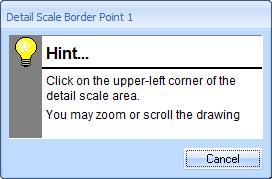Detail Scale Edit Window
A detail scale is a scale that applies to part of a drawing. This window is used to review or set a detail scale. This window is invoked from the Detail Scale List Window by pressing the “Add” or “Edit” button.
Note: You can scroll and zoom the drawing while you are setting the detail scale

Figure 1: The Detail Scale Edit Window
Detail Description – Enter a description of the detail (rather than the scale). This description is displayed in the list in the Detail Scale List Window.
Standard Scale – To use a standard scale for the detail (or start with a standard scale and modify it), press the down-arrow button and select a scale from the list.
Drawing Distance – Enter the scale’s distance on the drawing. You can enter this as a fraction if desired.
Drawing Units – Select the unit of measure for the drawing distance.
Actual Distance – Enter the scale’s actual distance. You can enter this as feet and inches if desired (such as “5-2” or “5-2 1/2”). Be sure to leave a space between the inches and the fraction.
Actual Units – Select the unit of measure for the actual distance.
Scale Description – The description of the scale is displayed on the Ribbon Bar’s Home Tab / Scale section. when you create or edit a measurement inside the detail area. When first defining the detail scale, you can leave this blank and Dimension will create a description automatically. It you don’t like the automatic description, just change it and Dimension will leave it alone.
Normalize… – The same scale can be described in many ways. The scales “1/4 inch = 1 foot”, “1 inch = 4 feet” and “2.25 inches = 9 feet” are identical. A “normalized” scale is one where either the drawing distance or the actual distance is one. If you press the Normalize button, Dimension will display a menu containing the three normalized scales. The third option uses 1 foot for the actual distance and sets the drawing distance to the nearest 1/16th of an inch. The percentage the adjusted scale is of the calibrated scale is displayed so you can see how significant the rounding is. Select a menu option to normalize the current scale or press the Escape key to keep the non-normalized scale.
Calibrate… – In some cases, the drawing scale may not be available, but one or more dimensions are specified on the drawing. In this case, you can specify the scale by “Calibrating” it. Press this button to start the calibration process (see Calibrating Scales).
Set Border… – A detail scale only applies to part of a drawing. When creating a new detail scale, you must set the border.
Warning: Measurements must have all points inside the detail area or all points outside the detail area. And detail areas may not overlap each other. Set the border carefully!
Follow the steps below to set the border:
- Press the “Set Border…” button. The scale edit window will disappear and the first Border Hint Window will appear.

Figure 2: The First Border Hint Window
Move the hint window or scroll and zoom the drawing as needed, then click on one corner of the detail area. You can press the hint window’s “Cancel” button to cancel border setting. - When you click on an end of the dimension, the first hint window will disappear and the second hint window will appear.

Figure 3: The Second Border Hint Window
Move the hint window or scroll and zoom the drawing as needed, then click on the opposite corner of the detail area. You can press the hint window’s “Back” button to re-do the first corner or press the “Cancel” button to cancel border setting. - When you click on the second corner, the second hint window will disappear and the scale edit window will re-appear. If the detail area overlaps any other detail area, or partially contains an existing measurement, you will see an error message. Otherwise the border has been set successfully.
OK – Press this button to finish setting the detail scale and return to the Detail Scale List Window.
Cancel – Press this button to cancel setting the drawing scale and return to the Detail Scale List Window.